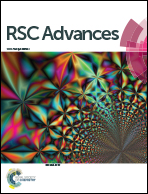Selective detection of hydrogen peroxide vapours using azo dyes
Abstract
A rapid and selective visual colour method is described for detection of hydrogen peroxide (H2O2) and peroxide based explosive (PBE) vapours by the combination of three azo dyes – Calmagite, Orange G and Orange II. The bleaching of these dyes by H2O2 is catalysed by MnII. At pH 8.0 (EPPS, N-2-hydroxyethyl-piperazine-N′-3-propanesulfonic acid) Calmagite is quickly degraded but under these conditions Orange G and Orange II are not perceptibly bleached, especially in the presence of ethylenediaminetetraacetic acid (H4edta). However, fast bleaching of Orange G and Orange II was observed at pH 9.0 (Na2CO3, sodium carbonate) due to the in situ formation of the carbonate radical (CO3−˙). Hence by a combination of Calmagite at pH 8.0, and Orange G and Orange II at pH 9.0, selectivity to H2O2 vapours against Cl2, NO2 and O3 can be demonstrated. Initial studies were carried out on filter papers but reaction times were slow. With Calmagite rapid colour changes, within 15 minutes, were found when the dye was deposited on to polyvinyl alcohol (PVA) polymer which had been coated onto a borosilicate glass plate. However, with Orange G and Orange II the colour changes on the PVA/plates were slow and this may be due to the limited availability of CO2, as the activating species, in generating CO3−˙.


 Please wait while we load your content...
Please wait while we load your content...